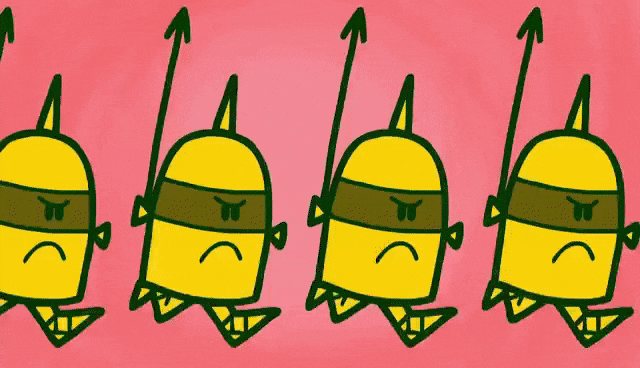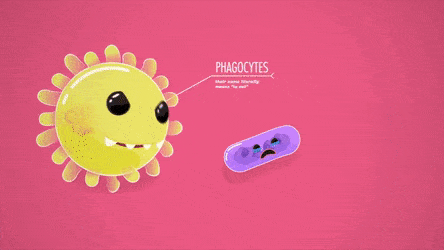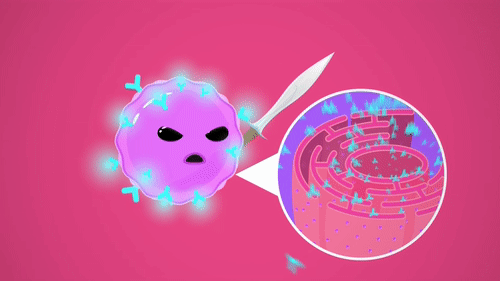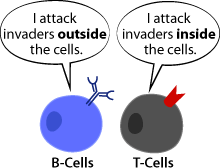Immunity
Now that we’ve learned about all the microorganisms out in the world that could potentially hurt and kill you, let’s learn about the reasons that they don’t: your immune system. Your immune system consists of 3 main layers of defense. The first is passive: things like skin and stomach acid that just keep out and kill off bacteria without your body really having to do anything differently. It keeps out most stuff. For the stuff that gets through, we have a nonspecific cellular system that recognizes the general features of bacteria and kills them off. Finally, we have a super-specific, ultra-elite squad of B cells and T cells that take care of whatever sneaky little demons somehow manage to weasel their way past the first two layers. Let’s learn more about each of these.
The first line of defense
The first line of defense sometimes isn't classified as part of the immune system, but it is nonetheless very important to keeping diseases at bay. It prevents germs from getting into your body in the first place. Think of it like putting up fortifications around a city: sure you can have soldiers and spies and all sorts of weapons, but what will really keep you safe from the enemy is preventing them from getting into your city. If they can't do this, then they are completely harmless.
Here are a couple of fortifications our bodies put up against pathogens:
Your skin is an organ that covers the entire body and separates it from the outside world. Besides acting as a physical barrier to germs, its slight acidity helps in the immune response by killing off the bacteria that can't survive in an acidic environment. It also secretes an oil called sebum, which lubricates the skin. This provides an added layer of protection against invading pathogens. Also, sweat glands in your skin keep the surface too salty for many bacteria to survive, and also flush away germs. It's like your skin has a built in shower! Sort of. Please take regular showers.
Mucous membranes line anything on the inside of your body that touches the outside world. This includes your nose, mouth, throat, anus, and urinary tract. Like skin, it acts as a physical barrier to prevent germs from getting into the bloodstream or to your vital organs. It also secretes mucus, which traps germs. When you cough up mucus or blow your nose, you are getting rid of these trapped pathogens.
Some other things included in the first line of defense are:
Here are a couple of fortifications our bodies put up against pathogens:
Your skin is an organ that covers the entire body and separates it from the outside world. Besides acting as a physical barrier to germs, its slight acidity helps in the immune response by killing off the bacteria that can't survive in an acidic environment. It also secretes an oil called sebum, which lubricates the skin. This provides an added layer of protection against invading pathogens. Also, sweat glands in your skin keep the surface too salty for many bacteria to survive, and also flush away germs. It's like your skin has a built in shower! Sort of. Please take regular showers.
Mucous membranes line anything on the inside of your body that touches the outside world. This includes your nose, mouth, throat, anus, and urinary tract. Like skin, it acts as a physical barrier to prevent germs from getting into the bloodstream or to your vital organs. It also secretes mucus, which traps germs. When you cough up mucus or blow your nose, you are getting rid of these trapped pathogens.
Some other things included in the first line of defense are:
- Tears, which flush germs out of the eyes.
- Urine, which flushes germs out of the urinary tract.
- Stomach acid, which kills many germs on contact.
- Nose hairs, which trap germs.
- Coughing and sneezing, which expel germs from the respiratory tract. This is why expectorants (like Mucinex) are helpful when you have a cold--they get you coughing, which gets out the mucus and all of the germs trapped in it.
- Some behaviors, such as leaning away from someone who sneezes.
The second line of defense
Though useful, having fortifications isn't always enough to prevent disease. So, let's say you get cut, or someone sneezes right in your face, or you nonchalantly touch a door handle that some sneaky dude with a cold touched mere moments ago. The enemy starts to invade. Now what?
We turn to our second line of defense. The second line of defense is also called the innate immune system because everyone has it from birth. It consists of leukocytes, or white blood cells, which circulate in the bloodstream. There are a few different types of leukocytes, but they all do essentially the same thing--phagocytize (eat) germs. Different chemical processes attract the phagocyte to the microbe. Once there, the phagocyte binds with the microbe and begins to engulf it. It then breaks down the microbe through a series of chemical processes, recycles the nutrients, and eliminates the waste. Eat your enemies!
Courtesy CrashCourse
Their mechanism of action may be a little different, but if the more advanced 3rd line of defense is like the super-elite squad of special agents and spies that know every in and out of one specific enemy looks like and know exactly how to target and kill that one guy, then the second line of defense is like an army. They know generally what the enemy looks like and they are very good at containing it. (Though, fortunately, modern warfare doesn’t really involve much cannibalism).
Fever and inflammation are also part of the second line of defense. They are natural reactions to infection and are actually helpful. Fever creates an environment that is too warm for many germs to survive. Basically, you are frying them to death. Unfortunately, fever is also non-selective, so it can also harm your cells. For this reason, high or prolonged fevers can be extremely dangerous.
Inflammation occurs when blood vessels in a certain area dilate so that more leukocytes can get to that area. When you are cut, nearby cells release a protein called histamine, which dilates blood vessels so that more leukocytes can get through. Blood vessel dilation also brings in more red blood cells, which is why inflamed areas are red, hot, and swollen. Meanwhile, different proteins called cytokines are released by dying cells as a sort of "SOS." They call leukocytes to destroy invading pathogens in the area. The leukocytes move out of the blood vessel and into the tissue, where they phagocytize invading germs. Here’s a video on inflammation:
Inflammation occurs when blood vessels in a certain area dilate so that more leukocytes can get to that area. When you are cut, nearby cells release a protein called histamine, which dilates blood vessels so that more leukocytes can get through. Blood vessel dilation also brings in more red blood cells, which is why inflamed areas are red, hot, and swollen. Meanwhile, different proteins called cytokines are released by dying cells as a sort of "SOS." They call leukocytes to destroy invading pathogens in the area. The leukocytes move out of the blood vessel and into the tissue, where they phagocytize invading germs. Here’s a video on inflammation:
the third line of defense
Say the enemy is a little too strong for soldiers alone--they've been sneaking around the city, outwitting even the strongest of soldiers and killing all of the citizens. It is time to employ the secret weapon. For the past two weeks, you have had spies tracking the enemy and learning their every move. Commence “Operation Antigen.”
Courtesy CrashCourse
The third line of defense is the most powerful line of defense because it is specific. It can take a few weeks to kick in because it spends so much time preparing the strongest attack possible. Cells called lymphocytes make up the third line of defense. These include B cells and T cells. B cells recognize bacteria and viruses that are floating around freely in your bloodstream. They release antibodies that prevent these pathogens from infecting your cells and also tag them for phagocytosis (kind of like tracking down the bad guy, alerting the soldiers, and letting them handle the dirty work). T cells recognize bad stuff in your cells once they’ve already gotten infected. They also recognize cancer cells. They then kill these cells before they can cause any more damage.
All lymphocytes have receptors that only recognize specific antigens. Antigens are special markings on microbes that make them recognizable. Each lymphocyte has a different type of receptor, so it will match up with a different microbe. Through mostly trial-and-error, each lymphocyte binds to the offending antigen to see which creates the best fit. The one with the best fit then replicates to form a specialized "army" of lymphocytes. This is called clonal selection. The clone army then goes to unleash its specialized antibody weapon—specifically targeted to a specific antigen—on offending viruses or bacteria, in the case of B cells, or directly kill infected (or cancerous) cells, in the case of T cells.
After the offenders are successfully destroyed, most of the lymphocytes disappear. The rest are converted to memory cells which will recognize the antigen more quickly if you get infected by the same thing again. "We will never forget!"
After the offenders are successfully destroyed, most of the lymphocytes disappear. The rest are converted to memory cells which will recognize the antigen more quickly if you get infected by the same thing again. "We will never forget!"
Summary
This video does a great job of summing up what I just described:
If you want a more complete story, this series does a great job of explaining the different levels of your immune response:
You should understand:
- That the first line of defense provides passive defense against pathogens getting into the body in the first place, like the skin, which provides a barrier.
- That the second line of defense involves non-specific cellular attacks that recognize the general features of bacteria and then do phagocytosis (eating) to destroy them. The second line of defense also includes fever, which tries to destroy invaders through heat, and inflammation, which is the swelling of blood vessels to get more phagocytotic cells to a damaged tissue.
- That the third line of defense is super-specific and is made up of lymphocytes that specifically identify a single antigen and then, through clonal selection, expand to create a massive army of lymphocytes specifically designed to attack that antigen.
- That B cells attack viruses and bacteria before they get into cells, and T cells attack infected and cancerous cells.
- That memory cells persist after an infection and attack a specific antigen again immediately the next time your body sees it, so that you don’t get sick from the exact two things twice.
Learning Activity
Content contributors: Emma Moulton and Emily Zhang




